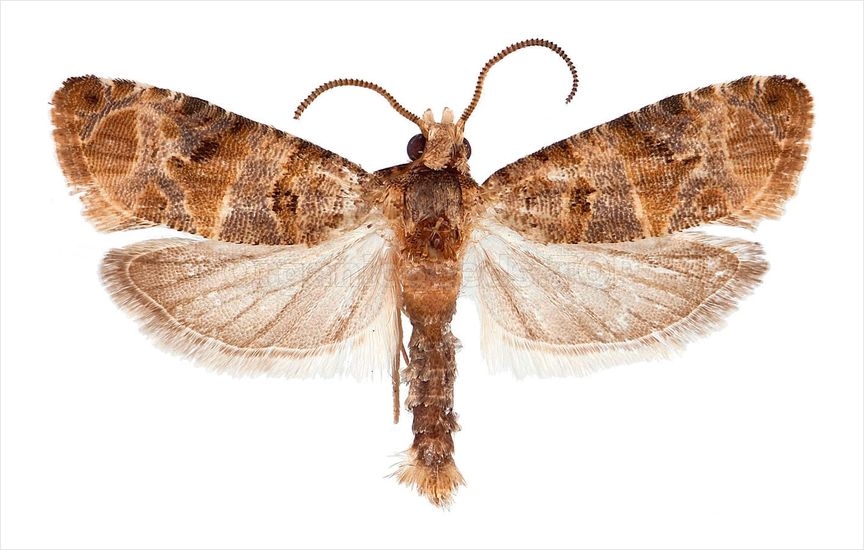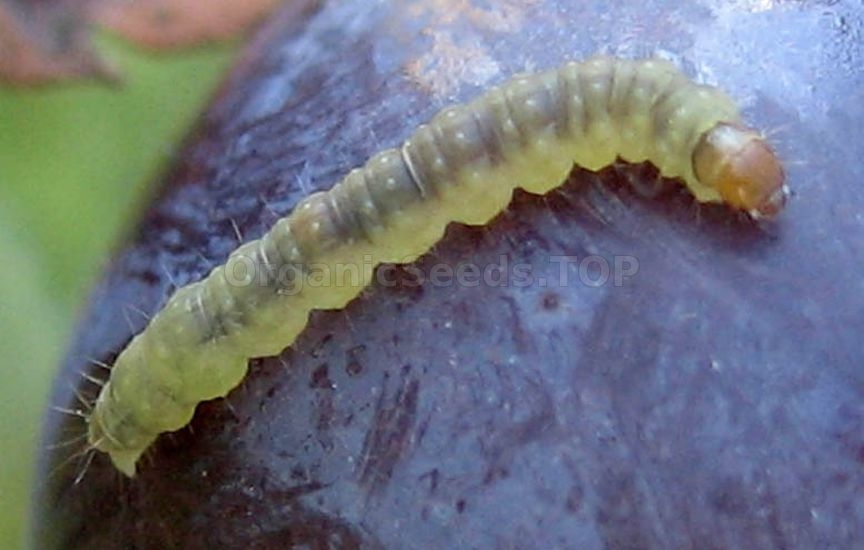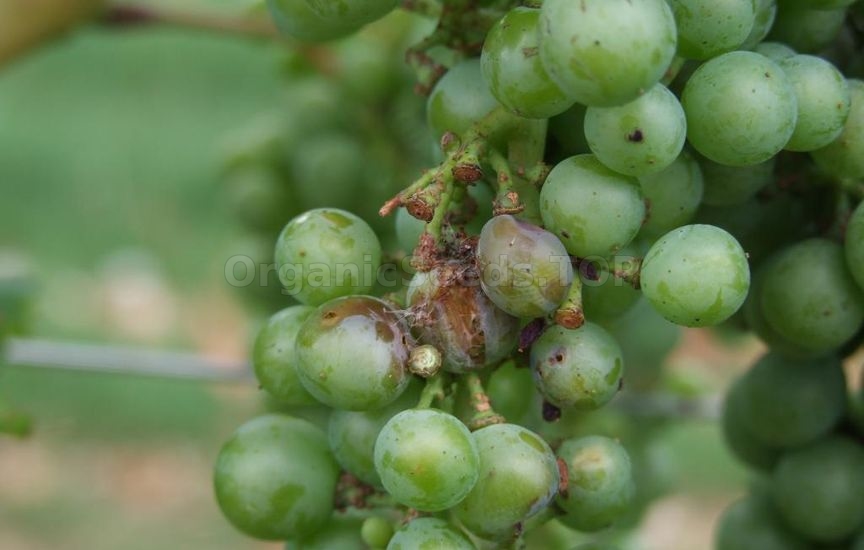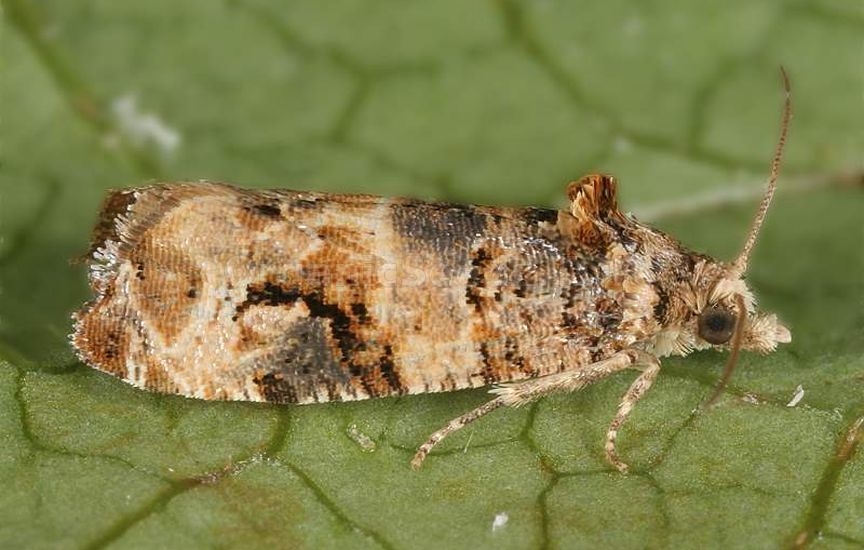Grapevine moth - «Lobesia botrana» |
 The grapevine moth - is a pest of grapes, berries and other crops. It develops successfully on privet, buckthorn, sloe, hawthorn, raspberry, currant, viburnum and other plants. It feeds on flowers, ovaries and fruits. Reproduction is bisexual, development is complete. Overwinters in the pupal stage. 3-4 generations appear per year. MorphologyImago
The butterfly is small. Wingspan - 10-12, 8-13, 9-15 mm. The forewings are olive-brown or brownish-brown in color with a wide, yellowish-whitish band with lead-gray streaks towards the middle of the wing surface and a strongly bent lead-gray band, which is decorated with light scales, behind the middle of the wing. Near the internal (tornal) corner there is a large buffy-yellow spot that spreads towards the anterior edge into a kind of band. The hind wings are gray, darker at the edges.  Sexual dimorphism Different-sex individuals of the species differ in the structure of their genitalia. In addition, in males the tibial brush on the tibia of the hind legs is long, the distal end of which extends beyond the base of the median pair of spurs, while in females it is short. Egg Size - 0.6 x 0.5 mm. The shape is slightly elliptical, flattened. Transparent, in gray with a rainbow tint on the rim. At first, the color of the eggs is light green, but as they develop, they become yellowish-brown. Larva Length - 10-12 mm. The color of the integument is yellow or olive green with a grayish tint. The head is light brown, the pectoral legs and the anterior pectoral shield are brown. The abdominal legs are equipped with a three-tiered crown with 40-42 claws, the anal legs are equipped with 24-30 claws in a medial horseshoe. Pupa Length - 5-6 mm. The color of the integument is brownish-yellow with a greenish tint and a yellow tip of the abdomen. The cremaster is small, has the appearance of a coarsely rough tubercle with eight hook-shaped setae on it. DevelopmentImago
The emergence of butterflies is observed in the spring, with a stable average daily temperature of + 14°C. The calendar dates for the emergence of butterflies change annually and depend on weather conditions. Mass emergence is observed 8-10 days after the start of summer. Flight duration is 15-25 days, in prolonged spring - 35 days or more. The summer period of generations closes, and butterflies are found in nature from spring to autumn. In spring, when the average daily temperature reaches + 14°C, the first generation of butterflies emerges. The number of generations depends on the climate of the area where the pest is distributed. In the conditions of southern Ukraine, the development of three generations of cluster budworm is usually observed. Mating period 2-3 days after departure, the butterflies mate. Egg laying begins on the 3-5th day after departure. The first generation lays from 60 to 160, with an average of about 80 eggs. The eggs of the first generation are located singly, sometimes in small groups of 2-5 pieces. The clutches are localized on the buds and flowers of the inflorescence. The second generation already lays eggs on unripe berries, and the third - on ripening berries. In rare cases, clutches appear on leaves and young shoots of grapes.  Egg Embryonic development of the first generation lasts 9-10 days at an average daily temperature of 17-20°C and relative humidity of 65-70%. The second and third generation of eggs complete their development in 5-7 days if the average daily temperature is close to 24-26°C and air humidity remains within 65-67%. Larva After rebirth, the larva (caterpillar) begins to feed on the buds. In this case, a wide and deep hole is formed in the bud, not only a significant part of the shell (hood), but also the stamens and pistil are destroyed. Then, with the help of a web, the larva attracts a neighboring bud and damages it in the same way as the first. Having damaged 2-3 buds in this way, the caterpillar molts for the first time, weaves a web tube among the buds of the inflorescence and lives in it. Subsequently, it damages all new buds, and then flowers and ovaries, attaching them to previously damaged parts of the plants. In this way, it forms a fairly dense web nest. During development, one caterpillar can destroy up to 40-60 buds, flowers and fruits, ovaries. Having completed development, the first generation larvae usually leave the feeding sites and pupate on the leaves under the curled edges, fastened with cobwebs. Partial pupation takes place among damaged inflorescences. The second generation first lives openly on the surface of the berries, eating away small depressions in them. After the first molt, they make a small hole in the skin of the berries and penetrate inside, gnawing a twisting passage in the pulp of the fruit under the very surface. Subsequently, a cavity is formed inside in which the larvae live and feed on the contents of the grape berries. After each moult, the caterpillars move into new berries, fastening the damaged ones with cobwebs. Pupates on leaves, sometimes among damaged, wrinkled and half-dried berries. Third generation caterpillars are reborn on ripening berries. They then penetrate the fruit and feed on the pulp. Damaged berries dry out in dry weather, and in damp weather they are affected by the gray rot fungus, infecting neighboring undamaged fruits. In wintering and pupating areas, the last generation of caterpillars of the year occurs during harvest. Pupa The pupal stage of the first generation lasts 10-12 days, the second - 7-8 days. The last generation of the year overwinters in the pupal stage. Overwintering pupae are located in white silky cocoons in cracks in the bark of trunks and perennial wood, as well as in the cracks of support posts, in damaged, dried brushes, among fallen leaves and in other secluded places. Every year, about half of the wintering pupae die from low temperatures, entomophages and fungal diseases.  The grapevine moth (caterpillar) damages vineyards in all viticulture zones and is characterized by a high degree of harmfulness. In the absence of protective measures or their untimeliness, it can destroy 35-45% of the crop, and in high numbers, the entire crop. The economic threshold of harmfulness for the grape budworm is established in the berry setting phase and is determined when 6.6-9.7 caterpillars are detected per bush or 10 caterpillars per 100 bunches of grapes.
You may need:«Grapevine moth» trapGlue trap (single adhesive cardboard) 205x125 mmPheromone traps |
|
|
